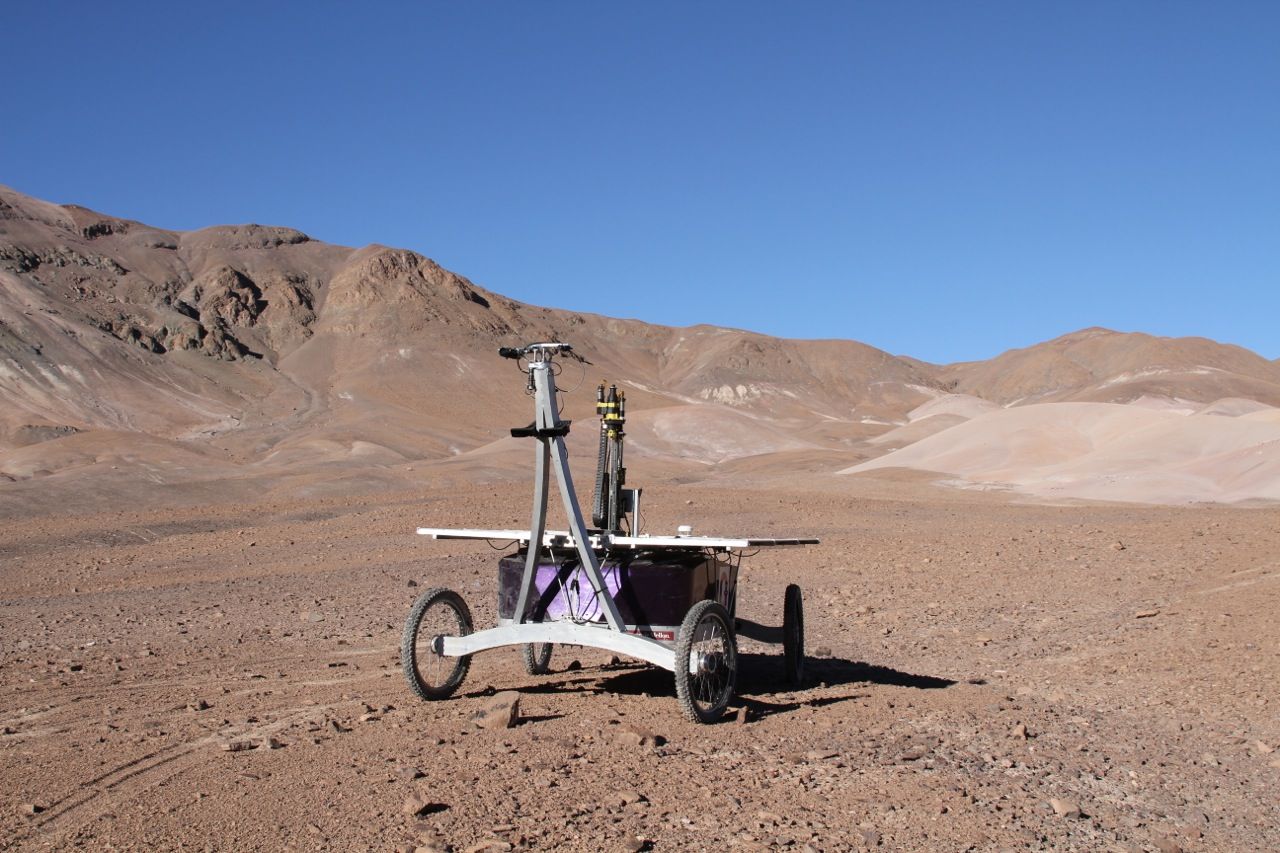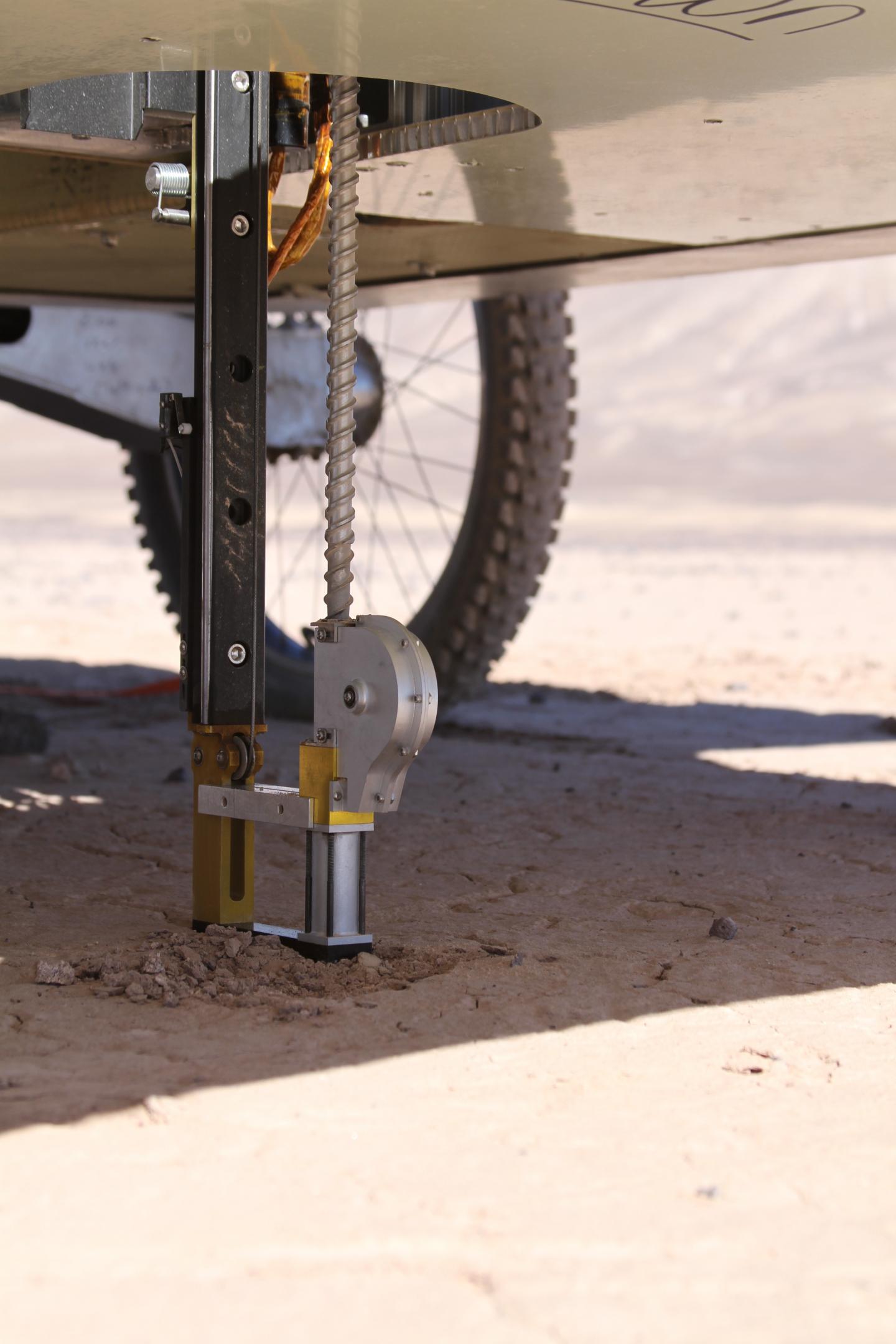CMU's Zoe Rover Shows Robots Can Find Subterranean Organisms Mission in Chile's Atacama Desert Will Aid Search for Life on Mars
Byron SpiceThursday, February 28, 2019Print this page.

An autonomous rover named Zoë, designed and built by Carnegie Mellon University's Robotics Institute, drilled into the soil of Chile's Atacama Desert in 2013 and discovered unusual, highly specialized microbes. The NASA-funded mission demonstrated how robots might someday find life on Mars.
The astrobiology mission was led by the Robotics Institute and the SETI Institute to test technologies for searching for life underground. The microbial analyses of the soil samples recovered by Zoë were published Feb. 28 in the journal Frontiers of Microbiology.
"This experiment culminates more than a decade of research at Carnegie Mellon developing robots that can autonomously explore the geology and microbiology of planetary surfaces," said David Wettergreen, research professor of robotics and principal investigator of the Life in the Atacama project. "Beginning in 2003, Zoë mapped more than 300 kilometers of traverse at eight field sites in the Atacama."
"We have shown that a robotic rover can recover subsurface soil in the most Mars-like desert on Earth," said Stephen Pointing, professor of environmental studies at Yale-NUS College, Singapore, who led the microbial research. "This is important because most scientists agree that any life on Mars would have to occur below the surface to escape the harsh surface conditions where high radiation, low temperature and lack of water make life unlikely."

Zoë, a solar-powered robot about the size of the Mars rovers, was equipped with a one-meter drill developed by Honeybee Robotics to recover soil samples deep below the surface. During the two-week experiment, the robot autonomously traversed 50 kilometers of the world's most arid desert, drilling and recovering samples several times each day.
Pointing said microbes recovered by Zoë were adapted to high salt levels. They are different than microbes found on the surface of deserts but likely are similar to what might be expected in the Martian subsurface. Soil samples recovered by the scientists yielded similar results, showing that the robot deployment was successful.
Both NASA and the European Space Agency plan to launch missions next year that would deploy rovers on Mars to drill below the surface in search of past or present life.
The microbial life discovered in the Atacama was patchy, which was related to water availability, scarce nutrients and soil chemistry. If life exists on Mars, it too is likely to be patchy, said co-authors Nathalie Cabrol and Kim Warren-Rhodes of the SETI Institute.
"While this will make detection more challenging, our findings provide a possible guide to the exploration for life on Mars, demonstrating that it is possible to detect life with smart robotic search and sampling strategies," they added.
The team has collaborated with Guillermo Chong, geology professor at the Catholic University of the North in Chile and an expert on the Atacama, to identify and study locations believed to be most similar to Mars.
Zoë first looked for life on the surface of the Atacama Desert during a NASA-funded field expedition in 2003. Early research developed multikilometer autonomous traverse and instrument targeting methods, which are both now used on NASA's Mars rovers. Initially, Zoë deployed a plow to scrape the surface and examine samples. A variety of instruments have been tested including prototypes for Raman and neutron spectrometers used in later space missions.
By 2012, the research focus was on automating exploration and the decision processes behind where to go and what samples to collect. Zoë was modified again for the 2013 experiment, with the addition of the deep drill. Analysis of results of an experiment in 2015, in which the field site experienced precipitation for the first time in 25 years, are ongoing.
"This research continues to develop new technologies and deliver exciting scientific discoveries," Wettergreen said. "And we foresee the need for more robotic exploration as we search for life in even more remote and complex environments, such as the moons Europa, Enceladus and Titan."
Byron Spice | 412-268-9068 | bspice@cs.cmu.edu
